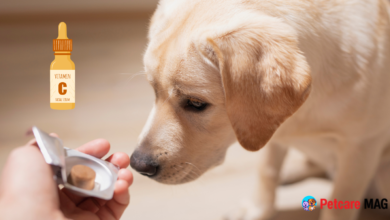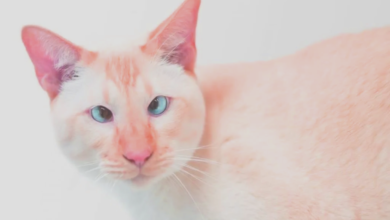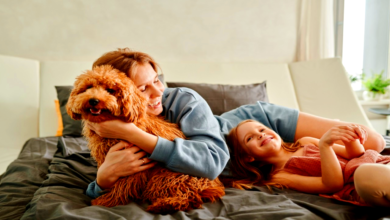
What Are the Essentials of a Pet-Friendly Home?
Pet-friendly homes are more than just aesthetically pleasing and convenient. It involves creating an atmosphere that promotes your dogs’ physical and emotional health in addition to ensuring their safety and comfort. This entails concentrating on the three fundamental needs of enrichment, comfort, and safety.
Safety: The Foundation of a Pet-Friendly Home
Making your house pet-friendly should come first and foremost with protecting your beloved animals. This entails getting rid of or protecting your pets from any possible risks. Every element of your property has to be carefully inspected and made safe for all occupants, from tiny, ingestible items and open windows to poisonous plants and common household chemicals.
Darina, the owner of MeoWoff Cattery, argues that safety should not come at the expense of convenience or elegance.”It’s about being aware of commonplace objects and circumstances that could endanger our pets and acting proactively to reduce those risks.”
Comfort: A Space for Rest and Relaxation
Your dogs should feel comfortable and at home in a pet-friendly house as well. This entails giving them private areas set aside for rest and relaxation, such comfortable mattresses, peaceful nooks, and secure hiding places. The goal is to provide a stress-free atmosphere that satisfies their innate demands for safety and relaxation.
Read More : 4 Ways a Pet Poop Clearing Service Can Transform Your Yard
The physical surroundings should also be pleasant, with lots of soft, supporting surfaces for resting and relaxing as well as a suitable interior temperature.
Enrichment: Stimulating Body and Mind
Last but not least, a very pet-friendly house gives dogs plenty of chances to participate in healthy activities and natural behaviours that challenge their bodies and brains. This offers access to windows for outside views, climbing frames, interactive toys, and scratching posts. Enrichment helps keep dogs from being bored or anxious, leading to a happier, more balanced existence.
Pet owners may design a living place that accommodates their dogs’ physical demands as well as their mental and emotional needs by concentrating on these three essentials: safety, comfort, and enrichment. This all-encompassing method of living with pets guarantees a contented and peaceful cohabitation for every family member.
How Can You Pet-Proof Your Living Spaces?
Making your living areas pet-friendly requires first completing the important step of pet-proofing. It entails a careful inspection of your house to find and remove any risks that can endanger your pets. Here’s how to make sure your furry family members are safe and secure in every room:
Living Room
Since the living room is the centre of activity, it is crucial to hide any tiny things and poisonous materials from pets, secure loose wires, and keep dogs away from large objects that might fall. To avoid any mishaps, think about using cord guards for electrical cables and making sure your furniture is sturdy.
Kitchen
Hazards abound in kitchens: sharp equipment, easily accessible garbage cans, and poisonous meals. Install child-proof locks on drawers and cupboards to prevent inquisitive hands from forcing them open.
Make sure all food is safely put away, and that rubbish is kept within a pet-proof container. Furthermore, use caution around hot surfaces and appliances since dogs may not be aware of the risks they provide.
Bathroom
Bathrooms are full with potentially dangerous objects, such as cleaning supplies, minor personal care products, and prescriptions. Use childproof locks or store all dangerous products in high cabinets.
Make sure the toilet lid is closed at all times to avoid the possibility of drowning or ingestion of dangerous cleaning agents. Additionally, while not in use, keep gadgets like straighteners and hair dryers disconnected and out of reach.
Bedrooms
Although bedrooms look secure, they may be choke risks due to little objects like jewellery, money, and prescriptions. To avoid falls, make sure your windows have sturdy screens, and keep any poisonous plants out of reach. Certain essential oils may be dangerous to animals, so if you use diffusers or essential oils, be sure they are pet-safe.
General Tips for Pet-Proofing
- Secure Trash Cans: To stop dogs from rooting through trash and perhaps consuming hazardous materials, use containers with lockable lids or keep them in locked cupboards.
- Store Hazardous Substances Safely: Keep any chemicals, cleaning supplies, and prescription drugs in locked drawers or high cabinets.
- Remove Toxic Plants: Pets cannot handle a lot of typical houseplants. Look into and get rid of anything that could be dangerous.
- Cover Open Vents: To avoid tiny dogs being lost or caught in vents or ducts, make sure they are covered.
What Are the Best Flooring Options for Pets?
Pet owners should think about flooring’s longevity, ease of cleaning, and comfort for their animals. Choices consist of:
- Hardwood: Durable but prone to scratches.
- Carpet: Soft but can harbor odors and stains.
- Tile: Easy to clean but hard and cold.
- Laminate: Scratch-resistant and easy to clean, but slippery for pets.
How Can You Ensure Your Pet Has a Comfortable Resting Area?
It’s crucial to set apart certain areas for your pet to unwind in order to ensure their comfort. This might incorporate comfortable pet beds in peaceful nooks, safe-sleeping cages, or even pet-friendly furniture. Creating a room where your pet feels secure and at ease is the aim.
What Outdoor Spaces Are Safe and Enjoyable for Pets?
Choosing safe plants, utilizing pet-safe landscaping materials, and securing the perimeter to prevent escapes are all important steps in building a pet-friendly yard or balcony for pet owners with outdoor areas. It’s also important to be mindful of any outside dangers to your pet, such as poisonous plants, fertilizers, and pesticides.
What Are the Best Practices for Maintaining a Clean and Healthy Home?
Keeping your house tidy is essential if you have pets. This entails using pet-safe cleaning supplies, regularly brushing and vacuuming your pet, and making sure your house is well-ventilated to reduce odours. Maintaining your pet’s health and minimizing shedding also need regular pet grooming.
How Can You Integrate Pet Needs into Your Home Decor?
Including your pet’s requirements into your décor may be a fascinating challenge that blends style and utility, particularly if your pet is a cat. Cats are renowned for their affection for curling up in warm places to climb and scratch. Fortunately, there are original methods to satisfy these requirements without compromising the interior design aesthetic of your house.
Choose Pet-Friendly Fabrics and Materials
Choose furniture made of materials that are simple to clean and long-lasting. For instance, pet owners should choose microfiber since it is easy to clean and scratch-resistant. Another suitable material is leather, which is somewhat scratch-proof yet can tolerate some wear and tear. Steer clear of tweed and other readily snagged materials, as well as delicate textiles like silk.
Create a Stylish Cat Corner
Assign a section of your room specifically for your cat’s activities. This may include a chic, contemporary cat tree that blends well with your interior design and a matching scratching post.
There are many of possibilities for stylish cat furniture that may be used as a focal point for your house as well as a practical area for your cat. Here’s where you may set up a hammock or a cozy cat bed for a relaxing place.
Incorporate Wall-Mounted Shelves and Perches
Cats like climbing trees to get a good look at their surroundings. Without taking up any floor space, wall-mounted shelves may be installed to provide your cat a vertical playroom. To make it easier for your cat to get from one level to the next, you may place these shelves in a staggered pattern. To easily incorporate them into your home design, choose finishes and colours that complement your wall or furniture.
Use Decorative Storage to Hide Cat Essentials
Arrange your cat’s toys, grooming supplies, and snacks in eye-catching boxes or baskets that complement the design of your space. This not only makes these things more accessible but also aids in decluttering your area. An elegant cabinet may also be used as a cover for a concealed litter box, which keeps your cat’s litter box out of sight but still accessible and minimizes odours.
Integrate Scratch-Resistant Surfaces Creatively
Wherever on your furniture where your cat is most prone to scratch, add panels or surfaces that are resistant to scratches. These might be a table’s legs or the sides of a specially-built bookcase. You may encircle these spots with materials like sisal cloth to provide your cat a secure and enticing place to scratch.
Read More : Cleaning Pet Urine From the Carpets: 5 Easy Ways To Do This
Decorative Yet Functional Cat Doors
Installing ornamental cat doors that complement your interior décor is a good idea if your home’s plan calls for them to provide access to various rooms or outside spaces. The style of your house may be complemented by a variety of styles, from traditional to contemporary.
Conclusion
In summary, designing a pet-friendly house is a commitment to our cherished friends’ safety, comfort, and enrichment it’s not just about looks. By putting safety first, offering cozy spots to relax, and adding enrichment activities, we create an environment where our dogs may grow both physically and mentally. By incorporating these ideas into our homes, we can make sure that humans and their dogs live in peace and happiness together.







